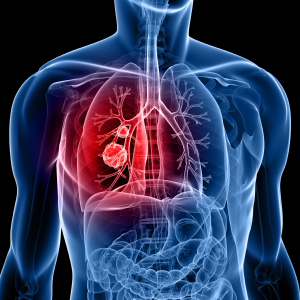Higher Breath Temperature Could Signal Lung Cancer
Exhaled breath temperature higher than 34 degrees Celsius (93.2 degrees F) could serve as a cutoff value to help diagnose lung cancer, according to a new study.
Breath temperature higher than 34° C (93.2° F) could serve as a cutoff value to help diagnose lung cancer.

Exhaled breath temperature higher than 34° C (93.2° F) could serve as a cutoff value to help diagnose lung cancer, according to a new pilot study. Patients who presented with suspicion of lung cancer almost universally had breath temperatures above that mark, in contrast to healthy control patients.
One of the study authors, Giulia Scioscia, MD, of the Hospital Clinic i Provincial de Barcelona in Spain, said at a press conference that airway inflammation and angiogenesis play key roles in the pathogenesis of lung cancer. Previous work has shown that exhaled breath temperature (EBT) is a marker of that sort of inflammation, as well as of increased vascularity and thus angiogenesis. EBT had not yet been directly studied as a diagnostic tool for non-small-cell lung cancer (NSCLC).
In the new study, presented on September 8 in Munich at the European Respiratory Society International Congress, researchers analyzed EBT in 82 consecutive patients presenting with radiologic suspicion of lung cancer. Forty of those patients were determined to have evidence of NSCLC, while the other 42 were false positives and served as controls in this study.
The group found a significantly higher EBT in the patients with NSCLC compared with those without any disease. The EBT was also correlated with specific smoking history in terms of pack-years, and was also associated with the stage of lung cancer.
For use as a diagnostic tool, a cutoff value of EBT would need to be validated. The study found a value of 34° C would serve best; 96% of the NSCLC patients had an EBT reading above that mark. The researchers did stress that this was only a small pilot study and these findings will need to be validated in bigger trials.
“Our results suggest that lung cancer causes an increase in the exhaled temperature. This is a significant finding and could change the way we currently diagnose the disease,” said the study’s lead author, Giovanna E. Carpagnano, MD, of the University of Foggia in Italy, in a press release. “If we are able to refine a test to diagnose lung cancer by measuring breath temperature, we will improve the diagnostic process by providing patients with a stress-free and simple test that is also cheaper and less intensive for clinicians.”
There is some question as to whether the test would work well in early-stage disease, when a non-invasive, simple diagnostic test would be most useful. Because EBT increased with presenting cancer stage, it may not be sensitive enough for early-stage cancers.